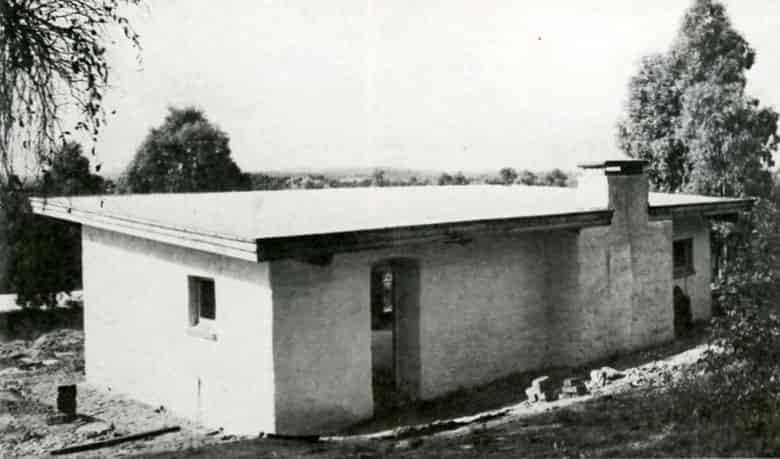Australian Regional Building, Chapter 7: Mud brick
Chapter 7: Mud brick
Author: Alistair Knox
No regional designer can afford to overlook earth building as a medium. In the nineteenth century, with the exception of a few very large homesteads, this method was regarded as a sign of poverty.
 Knox's first mud brick house, 1947
Knox's first mud brick house, 1947
I commenced building in the above in 1947 for two reasons. I was drawn to it as a medium, and it had in that time of unutterable shortages the wonderful capacity of being both cheap and plentiful. These attributes were persuasive enough, but a final factor was all-important. The material was human, emotional, and truly aesthetic. In the Australian scene, it was particularly timeless.
There was one problem, however, and that was that no council in Victoria knew anything about this ancient art. The first question was how to obtain a permit to build.
With an enthusiasm born of inexperience, I started to erect a small adobe house in Eltham. True, plans for the building had been lodged with the local council, which in those days was very local indeed. They met every now and again. There was no building surveyor. The building was about halfway up when they got to thinking about it.
By a fortuitous circumstance, the Commonwealth Experimental Building station at Ryde, in New South Wales, had been experimenting with earth construction to help overcome material shortages of that period. They produced a pamphlet on the very day the council were to consider whether earth building should be allowed within its boundaries, alongside the other one hundred and two houses and shacks spread over many square miles.
I caught one of the three morning trains that it was possible to catch into the city in those days. On arriving back at Eltham, the city fathers were discovered standing on the steps of the shire office, after a good luncheon at the local hotel.
The first remark I heard indicated that earth building had been the topic of the pre-lunch session, and the thoughts of the members were not all favourable towards it. 'Gentlemen', I said, offering the official-looking pamphlets, complete with photographs of some rather tragic little walls which had been erected. 'Perhaps these may help your deliberations on the important matters you are discussing'. They did. The council passed the plan, and so opened the door for all future earth building in Victoria, and, by default, in Australia. I sometimes feel that this chain of circumstances kept open a door for regional building. Had my train been five minutes late returning from the city (as it generally was), I should have missed the opportunity to present the documents of persuasion to them, and the emancipating medium may have been lost forever!
Its emergence produced a strange mixture of serious and comic opportunities. Publicity was not wanting, as the idea of earth being turned into structural walls appeared in the newspapers and architectural publications. Letters came from various parts of the world. Small packages of earth of different colours, with a request for an opinion, arrived fairly regularly. And every long-haired member of that post-war community asked, 'How much would it cost to build a mud-brick studio about twenty-by-thirty if I did all the work myself?' Some of them were to find out! It would prove to be the most strenuous work they had ever done. But those late 1940s were golden years in Australia. Years of relaxation and comfort after the war years. Quite a large proportion of society could not get accustomed to the idea of 9 to 5. There was a great shortage of labor everywhere. Managements were wearing fixed smiles, and offering cajolling conditions. Workers were skittish and strike-happy.
The major topic of conversation in the Eltham district became the art of building in earth. Both 'Pisé de Terre' and 'Adobe' methods were used. Adobe was always my choice. It was flexible in use, trouble-free in production, and vibrant in character.
Pisé de terre is static in comparison. It creates the look, and put the type of faade in building. It is not organic or modular, as adobe can be.
 The Busst house 1948
The Busst house 1948
The first sizeable adobe building I designed and constructed was the Busst house in Eltham.
Earth building is always a community affair. It is a relationship between idea and reality, through the medium of people who are enthusiastic to persevere in the transmuting of base clay into the exceedingly precious metal of true organic architecture. It is won from nature. It reflects nature and touches those indefinable inner springs of life that are the deep wells of existence. It has power to move the spirit, and release the imagination.
The Busst house taught me several fundamental lessons. The first was that earth movement is the cheapest form of building. The second, that the close relationship between the floor level and the immediate outside is the first essential in organic design. It produces the reality of the individuality of house and land in a way nothing else can.
< Previous Book
< Previous Chapter
:
Next Chapter >
Next Book >
